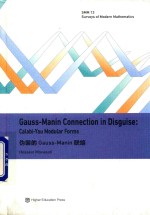

伪装的Gauss-Manin联络PDF电子书下载
- 电子书积分:9 积分如何计算积分?
- 作 者:(巴西)H.莫瓦萨蒂著
- 出 版 社:北京:高等教育出版社
- 出版年份:2017
- ISBN:9787040468632
- 页数:181 页
1 Introduction 1
1.1 What is Gauss-Manin connection in disguise? 3
1.2 Why mirror quintic Calabi-Yau threefold? 4
1.3 How to read the text? 5
1.4 Why differential Calabi-Yau modular form? 5
2 Summary of results and computations 7
2.1 Mirror quintic Calabi-Yau threefolds 7
2.2 Ramanujan differential equation 8
2.3 Modular vector fields 9
2.4 Geometric differential Calabi-Yau modular forms 11
2.5 Eisenstein series 12
2.6 Elliptic integrals and modular forms 14
2.7 Periods and differential Calabi-Yau modular forms,Ⅰ 15
2.8 Integrality of Fourier coefficients 17
2.9 Quasi-or differential modular forms 18
2.10 Functional equations 19
2.11 Conifold singularity 21
2.12 The Lie algebra sl2 22
2.13 BCOV holomorphic anomaly equation,Ⅰ 23
2.14 Gromov-Witten invariants 24
2.15 Periods and differential Calabi-Yau modular forms,Ⅱ 25
2.16 BCOV holomorphic anomaly equation,Ⅱ 28
2.17 The polynomial structure of partition functions 29
2.18 Future developments 30
3 Moduli of enhanced mirror quintics 31
3.1 What is mirror quintic? 31
3.2 Moduli space,Ⅰ 32
3.3 Gauss-Manin connection,Ⅰ 33
3.4 Intersection form and Hodge filtration 34
3.5 A vector field on S 35
3.6 Moduli space,Ⅱ 35
3.7 The Picard-Fuchs equation 36
3.8 Gauss-Manin connection,Ⅱ 37
3.9 Proof of Theorem 2 39
3.10 Algebraic group 39
3.11 Another vector field 41
3.12 Weights 42
3.13 A Lie algebra 43
4 Topology and periods 45
4.1 Period map 45
4.2 τ-locus 46
4.3 Positivity conditions 48
4.4 Generalized period domain 49
4.5 The algebraic group and τ-locus 50
4.6 Monodromy covering 51
4.7 A particular solution 52
4.8 Action of the monodromy 52
4.9 The solution in terms of periods 54
4.10 Computing periods 55
4.11 Algebraically independent periods 57
4.12 θ-locus 58
4.13 The algebraic group and the θ-locus 60
4.14 Comparing τ and θ-loci 61
4.15 All solutions of R0,?0 62
4.16 Around the elliptic point 62
4.17 Halphen property 63
4.18 Differential Calabi-Yau modular forms around the conifold 64
4.19 Logarithmic mirror map aroundthe conifold 65
4.20 Holomorphic mirror map 67
5 Formal power series solutions 69
5.1 Singularities of modular differential equations 69
5.2 q-expansion around maximal unipotent cusp 70
53 Another q-expansion 71
5.4 q-expansion around conifold 72
5.5 New coordinates 73
5.6 Holomorphic foliations 74
6 Topological string partition functions 75
6.1 Yamaguchi-Yau's elements 75
6.2 Proof of Theorem 8 76
6.3 Genus 1 topological partition function 77
6.4 Holomorphic anomaly equation 78
6.5 Proof of Proposition 1 80
6.6 The ambiguity of Falg g 81
6.7 Topological partition functions Falg g,g=2,3 82
6.8 Topological partition functions for elliptic curves 82
7 Holomorphic differential Calabi-Yau modular forms 85
7.1 Fourth-order differential equations 85
7.2 Hypergeometric differential equations 86
7.3 Picard-Fuchs equations 87
7.4 Intersection form 89
7.5 Maximal unipotent monodromy 91
7.6 The field of differential Calabi-Yau modular forms 92
7.7 The derivation 94
7.8 Yukawa coupling 94
7.9 q-expansion 95
8 Non-holomorphic differential Calabi-Yau modular forms 97
8.1 The differential field 97
8.2 Anti-holomorphic derivation 99
8.3 A new basis 100
8.4 Yamaguchi-Yau elements 101
8.5 Hypergeometric cases 103
9 BCOV holomorphic anomaly equation 105
9.1 Genus 1 topological partition function 105
9.2 The covariant derivative 106
9.3 Holomorphic anomaly equation 108
9.4 Master anomaly equation 108
9.5 Algebraic anomaly equation 109
9.6 Proof of Theorem 9 110
9.7 A kind of Gauss-Manin connection 111
9.8 Seven vector fields 112
9.9 Comparison of algebraic and holomorphic anomaly equations 113
9.10 Feynman rules 114
9.11 Structure of the ambiguity 116
10 Calabi-Yau modular forms 119
10.1 Classical modular forms 119
10.2 A general setting 120
10.3 The algebra of Calabi-Yau modular forms 121
11 Problems 125
11.1 Vanishing of periods 125
11.2 Hecke operators 126
11.3 Maximal Hodge structure 127
11.4 Monodromy 129
11.5 Torelli problem 129
11.6 Monstrous moonshine conjecture 130
11.7 Integrality of instanton numbers 131
11.8 Some product formulas 132
11.9 A new mirror map 133
11.10 Yet another coordinate 135
11.11 Gap condition 136
11.12 Algebraic gap condition 137
11.13 Arithmetic modularity 140
A Second-order linear differential equations 143
A.1 Holomorphic and non-holomorphic quasi-modular forms 143
A.2 Full quasi-modular forms 145
B Metric 147
B.1 Poincaré metric 148
B.2 K?hler metric for moduli of mirror quintics 149
C Integrality properties 151
HOSSEIN MOVASATI,KHOSRO M.SHOKRI 151
C.1 Introduction 151
C.2 Dwork map 155
C.3 Dwork lemma and theorem on hypergeometric functions 156
C.4 Consequences of Dwork's theorem 157
C.5 Proof of Theorem 13,Part 1 158
C.6 A problem in computational commutative algebra 158
C.7 The case n=2 159
C.8 The symmetry 160
C.9 Proof of Theorem 13,Part 2 160
C.10 Computational evidence for Conjecture 161
C.11 Proof of Corollary 1 162
D Kontsevich's formula 163
CARLOS MATHEUS 163
D.1 Examples of variations of Hodge structures of weight k 164
D.2 Lyapunov exponents 166
D.3 Kontsevich's formula in the classical setting 168
D.4 Kontsevich's formula in Calabi-Yau 3-folds setting 170
D.5 Simplicity of Lyapunov exponents of mirror quintics 173
References 175
- 《外星人联络记》(美)瑟维斯著;(美)格曼绘;成星瑶译 2013
- 《圆阵联络体操》王怀琪编 1928
- 《家庭联络实施法》李公谋编 1935
- 《修身、游技、唱歌联络教材 第1册》严树森编辑;傅球,孙掞校订 1921
- 《2008年华北、东北公路工程造价管理联络网会论文集》华北、东北公路工程造价管理联络网,内蒙古自治区公路局主编 2008
- 《2009年华北、东北公路工程造价管理联络网会论文集》华北、东北公路工程造价管理联络网,河北省公路工程定额站主编 2009
- 《敦煌学国际联络委员会通讯 2009》郝春文主编 2009
- 《对外贸易联络》薛书武编著 1995
- 《谢谢,再联络》单飞雪著 2005
- 《2010敦煌学国际联络委员会通讯》郝春文主编 2010
- 《中风偏瘫 脑萎缩 痴呆 最新治疗原则与方法》孙作东著 2004
- 《水面舰艇编队作战运筹分析》谭安胜著 2009
- 《王蒙文集 新版 35 评点《红楼梦》 上》王蒙著 2020
- 《TED说话的力量 世界优秀演讲者的口才秘诀》(坦桑)阿卡什·P.卡里亚著 2019
- 《燕堂夜话》蒋忠和著 2019
- 《经久》静水边著 2019
- 《魔法销售台词》(美)埃尔默·惠勒著 2019
- 《微表情密码》(波)卡西亚·韦佐夫斯基,(波)帕特里克·韦佐夫斯基著 2019
- 《看书琐记与作文秘诀》鲁迅著 2019
- 《酒国》莫言著 2019
- 《全国高等中医药行业“十三五”创新教材 中医药学概论》翟华强 2019
- 《培智学校义务教育实验教科书教师教学用书 生活适应 二年级 上》人民教育出版社,课程教材研究所,特殊教育课程教材研究中心编著 2019
- 《指向核心素养 北京十一学校名师教学设计 英语 七年级 上 配人教版》周志英总主编 2019
- 《习近平总书记教育重要论述讲义》本书编写组 2020
- 《办好人民满意的教育 全国教育满意度调查报告》(中国)中国教育科学研究院 2019
- 《高等数学试题与详解》西安电子科技大学高等数学教学团队 2019
- 《北京生态环境保护》《北京环境保护丛书》编委会编著 2018
- 《教育学考研应试宝典》徐影主编 2019
- 《语文教育教学实践探索》陈德收 2018
- 《家庭音乐素养教育》刘畅 2018
